Storms are a powerful force of nature. The rain nourishes the land and stimulates life and growth. The wind can bring much needed relief from the stifling heat and humidity of summer. But the wind and rain can also cause flooding, knock out power, topple large trees, and create other challenges in our lives.
When faced with those storm-related challenges, it’s easy to get caught up in the moment and focus on all the negatives. It’s much harder to look beyond the challenges and see the opportunities and potential positives that the situation may present. Anthony and I know. This is something we’re currently dealing with.
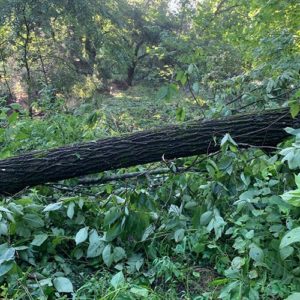
Recently I shared with you the story of how a storm came through, caused a lot of flooding, and knocked down a bunch of trees on our property. As I look around our storm-tossed woods and see all the fallen trees, I can’t help but feel sad and more than a little overwhelmed. The emails and messages I received after sharing our story tell me that you understand and can relate to those feelings too.
There’s a sense of sadness and loss when we discover a fallen tree or have one come down on our property. The bigger the tree; the sadder we often are. In some ways the response feels almost instinctive and ingrained into us. We mourn what the tree provided and represented – what it will no longer be able to provide.
However, the fallen tree isn’t really “lost.” It doesn’t just magically disappear after falling over or being blown down. (Although that would make storm cleanup much simpler.) Instead, when a storm knocks down a tree, the tree is still there. It may be lying on its side instead of standing up, but it’s still there. Being blown over, or otherwise falling down, marks a transition in a tree’s life and its ecological role – not just an ending, but also a beginning.
Fallen trees actually provide extremely valuable, and often overlooked, habitats. Like in their upright phase of life, fallen trees provide food and shelter for a wide variety of organisms. Let’s take a quick look at some of the new types of habitat created by fallen trees.
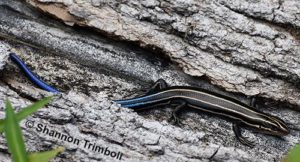
New Habitats Created by Fallen Trees
1) Pits and Mounds: Unearthing New Habitats
Sometimes when a tree is blown over, its roots are pulled out of the ground. When this happens, two distinct types of habitat are created at the base of the tree. A pit is created where the roots used to be. A mound is created where the soil was peeled back as the roots were pried out of the ground.
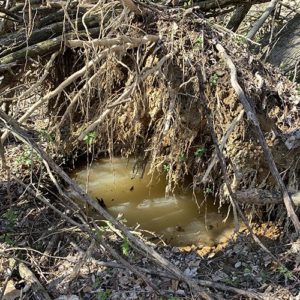
Depending on the type of soil present, the pit may fill up and hold stormwater for several days to several weeks – sometimes even longer. If the soils allow it to hold water, the pit will serve as a temporary watering hole for deer, turkey, and other wildlife. If the pit holds water for weeks or longer, then it may function as a short-term vernal or transient pool and provide valuable breeding habitat for a variety of frogs, salamanders, and other semi-aquatic organisms. Every new storm will refill the pool created by the pit, until many years later the pit naturally fills in with sediments and fallen leaves.
Even if the soils are such that the pit drains quickly, it is likely to be slightly cooler and damper than the surrounding, undisturbed ground. Even slight changes such as those found in a pit can create microclimates and microhabitats attractive to a wide variety of plants and animals.
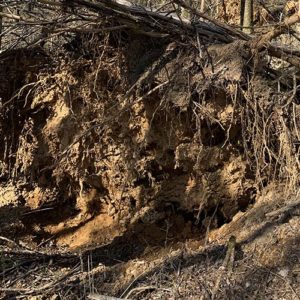
The mound created by the upturned root wad creates another important habitat type. Immediately after being exposed, the mound becomes a buffet for birds and other critters searching for easily accessible grubs. The newly exposed soil surrounding the root wad creates a wealth of sites for ground nesting bees and other insects that need similar types of nesting habitat. Over time, ferns and other small plants may begin to colonize the exposed face of the soil surrounding the root wad. As the roots decompose and begin to crumble, part of the soil may break off and help fill in the pit created when the tree fell.
2) Trunk Habitat: Creating a Thriving Ecosystem and Highway
The trunks of fallen trees (aka logs) are an extremely important and valuable habitat type in forests. Many different types of salamanders, millipedes, and other critters will seek shelter in the cooler, damper environment under the log. As the bark loosens up on the log, everything from pleasing fungus beetles to fence lizards will seek shelter there.
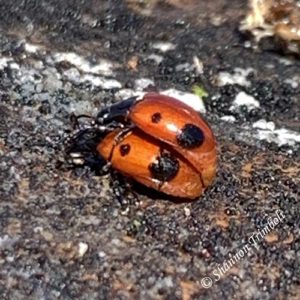
Mushrooms and other types of fungi, not to mention slime molds, will quickly colonize the log and begin the process of decomposition. Beetles and wood boring bees will also move into the fallen logs which provide nurseries for their young.
The presence of beetle larvae and other wood boring insects is like ringing a dinner bell for woodpeckers. They aren’t picky and will forage from fallen trees as quickly as from standing ones. Other birds will also often forage along the log picking at loose bark and gobbling down insects they find.
As the log rots and becomes hollow, it may provide shelter for a wide range of mammals depending on the size of the log and the cavity. In addition to the shelter and foraging opportunities provided by the log, it can also serve as a small mammal superhighway. Logs are a favorite place for everything from mice to squirrels to raccoons and more to travel above the dense vegetation growing around the log.
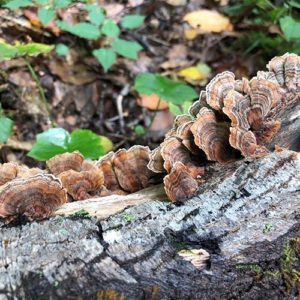
3) Seedling Nursery: Increasing Biodiversity in Canopy Gaps
Once a tree comes down, especially in a forest or woodlot, it creates what is known as a canopy gap. Simply put, a canopy gap is just a hole in an otherwise closed or mostly closed tree canopy. Or put another way, a gap in the woods.
This gap in the woods allows more light to reach the ground which stimulates a flush of new growth from saplings and seedlings in the area. This new growth can increase species diversity in the forest understory because species that thrive in the sunnier gaps may not be the same species that thrived in the shadier locations under the tree’s canopy.
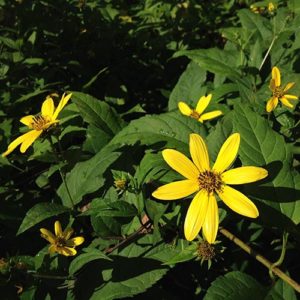
All that tender, fresh, new plant growth is going to also attract deer. And let’s face it, in much of the eastern U.S. our white-tail deer populations are way overpopulated. Numerous research studies have shown that high deer populations in wilder areas can have significant negative impacts on many native plant species, especially herbaceous plants or what we commonly call flowers. Many native plant gardeners can attest to this also being true in garden or “less wild” situations.
However, that’s one of the ways that treetops from fallen trees can provide important microhabitats. In the areas where the branches are open enough to allow sunlight to hit the ground, new seedlings and saplings will sprout under the branches. The branches and twigs above them will provide a bit of screening and protection from hungry deer because nothing likes to have their eyes poked by sticks as they try to eat. These “seedling nurseries” allow the new seedlings and saplings to get established before being exposed to the pressures of browsing deer.
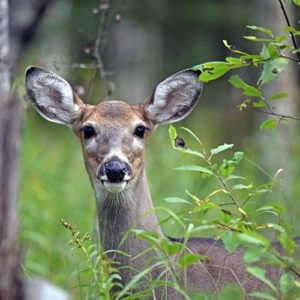
4) Brush Pile: Providing Dense Hiding Places
Parts of the treetop where the branches are denser and don’t allow much light to hit the ground are important in a different way. These denser portions of the treetops form natural brush piles. Brush piles provide shelter as well as foraging locations for a wide variety of insects, birds, mammals, and more. The sparsely vegetated ground beneath a brush pile can also provide important nesting sites for ground nesting bees.
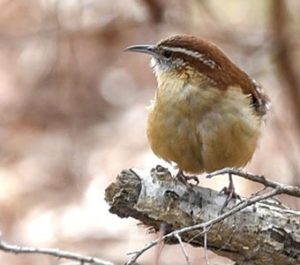
So, should we leave every fallen tree?
Absolutely not. Like with anything else when we are talking about creating or managing habitat around our homes, it’s about finding the right balance for your specific location and situation.
Anthony and I will be cleaning up and removing many of the fallen trees on our property. Why? Because we need to be able to safely move through our property. Right now, there are too many trees either completely down or hanging up in other trees.
The hanging trees or branches are a safety issue. If they come down when someone happens to be walking under them, then very bad things can happen. There’s a reason branches and trees that are hung up in other trees are called widow makers.
Just the sheer number of fallen trees, even those completely on the ground, also pose a problem. In some places, there are so many on the ground that it’s hard to walk through that area, not just for us but also for the deer, turkey, and other wildlife that call our property home. It’s a completely tangled mess.
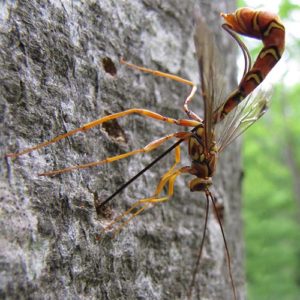
Waiting for all of it to decay naturally would take years. Or we can help Mother Nature out by removing some of it ourselves. Notice I said some, not all. Remember… it’s about finding a balance and that balance is going to be different in every location and situation.
Over the next few months, we’ll be evaluating each location on the farm to determine how to address the current situation based on our overall goals and plans. As much as I feel the sadness that comes with losing so many trees in such an unexpected way, I’m also excited to see what comes next.
And, as more time passes, the excitement grows and the sadness fades. The overwhelm is still there if I allow myself to dwell on it too much. (I have no idea how we’re going to accomplish the amount of cleanup we need to do.) But I am definitely excited to see who shows up in these new habitats over the next several years. (We’re looking forward to lots of Bess bugs among other things.)
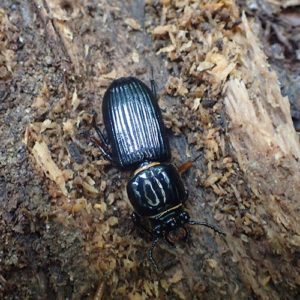
The next time you find a fallen tree in the woods or have one come down on your property, I encourage you to remember that it is still playing an important role in the ecosystem. It’s ok to be sad that the upright phase of the tree’s life is over, but also recognize the transition and opportunities that the fallen tree presents.
True, if the tree is in the middle of your yard, then leaving it isn’t a realistic option. But if it’s not in your yard and is in a place where it can be left, then you just had a whole new world of exciting discoveries and habitats open up.
As I wrap up, I want to remind you that incorporating native plants into your landscape is a great way to improve the habitat in your yard for butterflies, hummingbirds, songbirds, and just about every other type of animal that visits your property. If you want to learn more about gardening with native plants, then I’d like to give you a free copy of our e-book, An Introduction to Gardening with Native Plants: Hardiness Zones and Ecoregions.
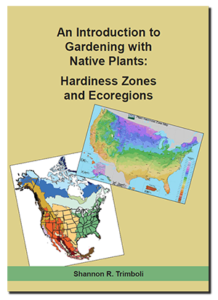
Until next week I encourage you to take some time to explore the nature in your yard and community.

Backyard Ecology: Exploring Nature in Your Backyard
Nature isn’t just “out there.” It’s all around us, including right outside our doors. Hi, my name is Shannon Trimboli, and I am the host of Backyard Ecology. I live in southcentral Kentucky and am a wildlife biologist, educator, author, beekeeper, and owner of a nursery specializing in plants for pollinators and wildlife conservation. I invite you to join me as we ignite our curiosity and natural wonder, explore our yards and communities, and improve our local pollinator and wildlife habitat. Learn more or subscribe to my email list at www.backyardecology.net.

Leave a Reply